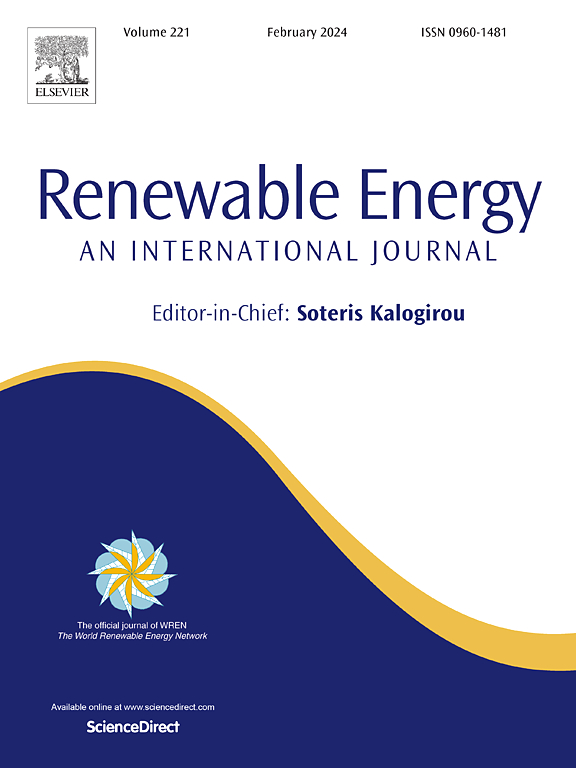通过去除棕榈油厂废水中的酚类化合物提高甲烷产量和微生物群落动态
IF 9
1区 工程技术
Q1 ENERGY & FUELS
引用次数: 0
摘要
本研究评估了从棕榈油厂废水(POME)中去除酚类化合物对厌氧消化中甲烷产量的影响。实验在可控厌氧条件下(37°C, pH 7.0)进行了小型和大型实验。在小规模试验中,最佳接种量:生POME:提取POME比例为5:0:1时,累积甲烷产量最大为559.80 mL-CH4/g-VS,是5:1:0比例的2.68倍。去除酚类化合物后,最大产甲烷率(MMPR)由24.72 mL-CH4/g-VS·d提高到125.90 mL-CH4/g-VS·d。微生物群落分析显示优势种发生变化,第3 ~ 15天Methanosaeta从88.75%增加到97.36%,促进了丙酮裂解产甲烷。大规模试验证实了这一趋势,在5:0:1的比例下,甲烷产率达到1221.00 mL-CH4/g-VS,比5:1:0的比例(158.50 mL-CH4/g-VS)高出约7.7倍。去除93%以上的酚类化合物不仅提高了甲烷产量,还降低了消化毒性,使环境排放更安全。萃取系统每批次产生3882.89 m3甲烷,收益1037.67美元,显著优于非萃取系统(1143.32 m3, 305.54美元)。尽管初始成本较高,但甲烷产量的提高表明具有很强的经济可行性。这些发现表明,去除酚类化合物可显著提高甲烷产量和工艺效率,为POME生产沼气提供了可持续和可扩展的策略,有助于环境可持续性和资源回收。本文章由计算机程序翻译,如有差异,请以英文原文为准。
Enhancing methane production and microbial community dynamics by removing phenolic compounds from palm oil mill effluent
This study evaluates the impact of phenolic compound removal from raw Palm Oil Mill Effluent (POME) on methane production in anaerobic digestion. Experiments were conducted at both small and large scales under controlled anaerobic conditions (37 °C, pH 7.0). In small-scale trials, the optimal inoculum: raw POME: extracted POME ratio of 5:0:1 resulted in a maximum cumulative methane yield of 559.80 mL-CH4/g-VS, which was 2.68 times higher than the 5:1:0 ratio. The maximum methane production rate (MMPR) increased from 24.72 to 125.90 mL-CH4/g-VS·day following phenolic compound removal. Microbial community analysis revealed a shift in dominant species, with Methanosaeta increasing from 88.75 % on Day 3–97.36 % on Day 15, enhancing acetoclastic methanogenesis. Large-scale trials confirmed the trend, with methane yield reaching 1221.00 mL-CH4/g-VS for the 5:0:1 ratio, approximately 7.7 times higher than that of the 5:1:0 ratio (158.50 mL-CH4/g-VS). The removal of more than 93 % of phenolic compounds not only improved methane production but also reduced digestate toxicity, enabling safer environmental discharge. The extraction system generated 3882.89 m3 of methane per batch, yielding 1037.67 USD, significantly outperforming the non-extraction system (1143.32 m3, 305.54 USD). Despite higher initial costs, the improved methane yield suggests strong economic viability. These findings demonstrate that phenolic compound removal significantly enhances methane yield and process efficiency, providing a sustainable and scalable strategy for biogas production from POME, contributing to environmental sustainability and resource recovery.
求助全文
通过发布文献求助,成功后即可免费获取论文全文。
去求助
来源期刊

Renewable Energy
工程技术-能源与燃料
CiteScore
18.40
自引率
9.20%
发文量
1955
审稿时长
6.6 months
期刊介绍:
Renewable Energy journal is dedicated to advancing knowledge and disseminating insights on various topics and technologies within renewable energy systems and components. Our mission is to support researchers, engineers, economists, manufacturers, NGOs, associations, and societies in staying updated on new developments in their respective fields and applying alternative energy solutions to current practices.
As an international, multidisciplinary journal in renewable energy engineering and research, we strive to be a premier peer-reviewed platform and a trusted source of original research and reviews in the field of renewable energy. Join us in our endeavor to drive innovation and progress in sustainable energy solutions.
 求助内容:
求助内容: 应助结果提醒方式:
应助结果提醒方式:


